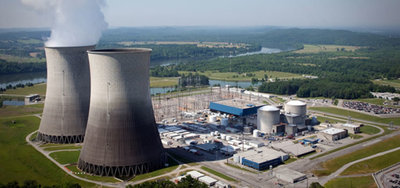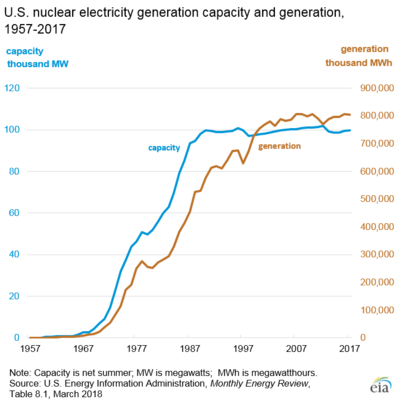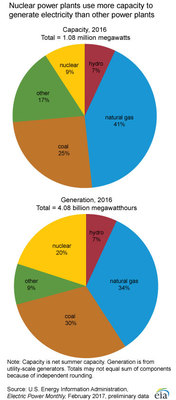Current Status of Nuclear Power
Introduction

(click image to enlarge)
Construction of nuclear power plants in the United States has been almost totally dormant for many years. After a flurry of building in the 1960's and 70's, interest in new nuclear power plants reached a peak then declined through the 80's. Ultimately, construction of nuclear power reactors dropped steeply, even as numerous existing plants, due to age, were taken out of service. Four reactors were permanently shut down in 2013, and one reactor was taken out of service in 2014. The newest reactor to enter service, Watts Bar Unit 2, came online in 2016.
The reasons for this history are numerous and varied, but the overriding concerns that have impeded development of a nuclear power option in the U.S. have been excessive cost and indeterminate risk. The time that it takes to build a plant can run (unpredictably) 4-10 years or more, making financing very expensive and risk assessment extremely uncertain. However, despite the slow-down in nuclear plant construction, in 2016 existing nuclear power plants contributed 20% of the power generated in the United States.
In fact, nuclear energy remains an attractive source of energy to many analysts, and it appears to be undergoing a modern renaissance of interest on the part of utility and governmental decision-makers. A nuclear power plant may be slow and expensive to get started, but the power that comes from it is carbon-free, steady and reliable. Furthermore, the cost of the fuel is low and its availability is highly dependable.
However, like all politically charged issues, there are two sides. Waste disposal may or may not be a solved technology. The possibility of nuclear proliferation can never be fully discounted, and terrorist attack or sabotage might occur, no matter how carefully a plant is safeguarded. There is also a significant use of carbon-based fuels in the mining and refining of uranium, the disposal of waste, and the decommissioning of old plants.
Top Nuclear Power Generating Countries
The U.S. produces more electricity from nuclear fission than any other country. In 2015 its nuclear electric generation capacity was 99 million kilowatts. The U.S. produced 19.5% of its electricity from nuclear fission.
France was second in 2015 with a nuclear fission generation capacity of 63 million kilowatts. France produced 77.6% of its electricity from nuclear fission.
Russia was third with 35 million kilowatts capacity, producing 18.1% of its electricity.
China was fourth with 27 million kilowatts capacity, producing 2.9% of China's electricity.
Finally, South Korea was fifth with a 22 million kilowatts capacity, which produced 30.4% of its electricity
U.S. Nuclear Capacity and Generation

In the U.S. the capacity for nuclear power generation of electricity is closely matched by the actual generation of electricity by nuclear means. This is in contrast to coal or natural gas plants that do not generate electricity at a rate fully comparable to their capacity.
Nuclear Generation vs Coal and NG

The above diagrams show the difference between nuclear and coal and natural gas, when comparing capacity for electricity generation and actual generation. The diagrams show that nuclear power generates electricity in greater proportion to its capacity than both coal and natural gas.